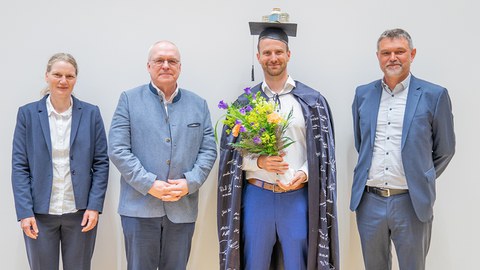Jun 24, 2025
Promotion Peter Betz

Peter Betz and the doctoral committee present
On 23.06.2025, Dipl.-Ing. Peter Betz successfully defended his scientific thesis as part of the doctoral procedure 👨🎓 with the topic "Carbon-reinforced concrete under compression loads – Influence of transversal compression and tension". In addition to the chairman of the doctoral committee, Prof. Dr. Alexander Zeißler (TU Dresden), Prof. Dr.-Ing. Dr.-Ing. E.h. em. Manfred Curbach (TU Dresden) was present as a reviewer. Prof. Dr. Torsten Leutbecher (University of Siegen) and Prof. Dr. Martin Claßen (RWTH Aachen) were connected online. Prof. Dr. Birgit Beckmann (TU Dresden) was also present as a member of the doctoral committee.
Abstract:
Characteristics of carbon reinforcement include a high tensile load-bearing capacity and corrosion resistance. Consequently, components made of carbon-reinforced concrete (CRC) can be designed to have a significantly higher degree of slenderness than their conventionally reinforced concrete counterparts. Although extensive research has been dedicated to investigating the tensile load-bearing behaviour of carbon concrete, there is still limited knowledge of the compressive load-bearing capacity of this filigree construction method.
This thesis constitutes a preliminary systematic investigation into the load-bearing behaviour of CRC under uniaxial compressive loading, using small-format test specimens, incorporating various non-metallic reinforcement grids. The findings reveal a negative impact of the reinforcement on the compressive load-bearing capacity of the test specimens. However, it is important to note that purely uniaxial compressive stresses rarely occur in reality. Multi-axial stress states are of particular relevance for the material's broad application in construction. In steel-reinforced concrete construction, it is assumed that the concrete's compressive strength increases under multiaxial compressive stress states, while it is reduced if cracking or transverse tensile stress is present.
In order to determine the extent to which these assumptions can be applied to CRC construction, the present work investigates the load-bearing behaviour of CRC under compressive loading with additional transverse compressive and tensile stresses. Discs made of fine-grained concrete with dimensions of 200 × 200 × 40 mm in length, width and thickness, reinforced with carbon grids, are subjected to biaxial compressive and combined compressive-tensile loading. The focal point of the parameter studies is the variation of the manufacturing method (laminated or cast) and the degree of reinforcement (different number of layers, mesh size and yarn diameter) of the test specimens, as well as the impregnation materials and the orientation of the carbon reinforcement. The achieved compressive load-bearing capacities of the test specimens are evaluated as a function of the compressive and tensile load in the secondary axis.
First, the results of the parameter studies are used to conduct a more detailed analysis of the load-bearing behaviour under uniaxial compressive loading. Subsequently, based on known material models from steel-reinforced concrete construction, approaches are derived to consider the influence of carbon reinforcement on the biaxial compression behaviour. These can be used as a basis for the guideline for concrete components with non-metallic reinforcement. The knowledge gained in this work on the compression behaviour of carbon reinforced concrete components thus makes an important contribution to establishing the construction method in practice.
Dear Peter, we wish you success in your future scientific career and, of course, all the best for your future! 👍🥳
